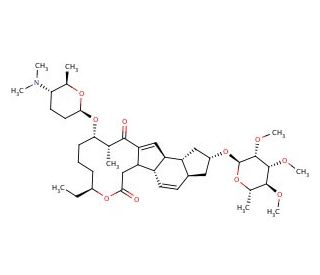

Molekülstruktur von Spinosad, CAS-Nummer: 168316-95-8
Spinosad (CAS 168316-95-8)
Produktreferenzen ansehen (1)
Anwendungen:
Spinosad ist eine Referenznorm
CAS Nummer:
168316-95-8
Molekulargewicht:
1477.93
Summenformel:
C83H132N2O20
Ergänzende Informationen:
Dieses Produkt wird als Gefahrgut eingestuft und unterliegt möglicherweise zusätzlichen Versandkosten.
Ausschließlich für Forschungszwecke. Nicht Geeignet für Verwendung in Diagnostik oder Therapie.
* Schauen Sie auf das Analysezertifikat (CoA), um die genauen Daten (inkl. Wassergehalt) Ihrer Produktionscharge (Lot) zu sehen.
Direktverknüpfungen
Bestellinformation
Publikationen
Beschreibung
Hintergrundinformationen
Sicherheitshinweis
SDS (SDB) & Analysenzertifikate
Spinosad ist ein analytischer, chromatographischer und ökologischer Standard. Spinosad ist ein Insektizid, das in dem Bodenbakterium S. spinosa vorkommt. Es besteht aus einer Mischung von zwei makrozyklischen Laktonen, Spinosyn A und Spinosyn D. Diese Verbindungen wirken als Agonisten und binden an die Acetylcholinesterase-Rezeptoren (nAChRs) von Insekten. Der Wirkstoff wird in der Umwelt schnell abgebaut, so dass er im Boden über längere Zeiträume nur begrenzt persistent ist.
Spinosad (CAS 168316-95-8) Literaturhinweise
- Ein Überblick über Spinosad als natürliches Produkt zur Bekämpfung von Stechmückenlarven. | Hertlein, MB., et al. 2010. J Am Mosq Control Assoc. 26: 67-87. PMID: 20402353
- Hohe Spinosad-Produktion in dem heterologen Wirt Saccharopolyspora erythraea. | Huang, J., et al. 2016. Appl Environ Microbiol. 82: 5603-11. PMID: 27401975
- Spinosad induziert die Autophagie von Spodoptera frugiperda Sf9-Zellen und die Aktivierung des AMPK/mTOR-Signalweges. | Yang, M., et al. 2017. Comp Biochem Physiol C Toxicol Pharmacol. 195: 52-59. PMID: 28223193
- Spinosad-vermittelte Effekte auf die Gehfähigkeit, den Mitteldarm und die Malpighischen Röhren von afrikanisierten Honigbienenarbeiterinnen. | Lopes, MP., et al. 2018. Pest Manag Sci. 74: 1311-1318. PMID: 29194936
- Strategien zur Steigerung der Ausbeute des wirksamen Insektizids Spinosad in Actinomycetes. | Tao, H., et al. 2019. Biotechnol J. 14: e1700769. PMID: 29897659
- Zytotoxische Wirkungen des Bio-Pestizids Spinosad auf menschliche Lungenzellen A549. | Zhang, Y., et al. 2019. Chemosphere. 230: 182-189. PMID: 31103864
- Das Biopestizid Spinosad führt bei Honigbienen (Apis mellifera) in subletalen Konzentrationen zu Transkriptionsveränderungen in Genen, die mit der Energieproduktion zusammenhängen. | Christen, V., et al. 2019. J Hazard Mater. 378: 120736. PMID: 31202068
- Eigenschaften, Toxizität und aktuelle Anwendungen des Biolarvizids Spinosad. | Santos, VSV. and Pereira, BB. 2020. J Toxicol Environ Health B Crit Rev. 23: 13-26. PMID: 31709913
- Die Anwendung von Spinosad in einer Apfelplantage wirkt sich sowohl auf die Häufigkeit der Spinne Araneus diadematus als auch auf ihr Netzbauverhalten aus. | Mazzia, C., et al. 2020. Ecotoxicology. 29: 389-397. PMID: 32274624
- Neue Erkenntnisse über die Auswirkungen von Spinosad auf die Entwicklung von Helicoverpa armigera. | Yao, S., et al. 2021. Ecotoxicol Environ Saf. 221: 112452. PMID: 34198186
- Spinosad-Resistenz bei Feldpopulationen der Melonenfliege, Zeugodacus cucurbitae (Coquillett), auf Hawaii. | Hsu, JC., et al. 2021. Pest Manag Sci. 77: 5439-5444. PMID: 34331843
- Vermehrung der heterologen Produktion von Spinosad durch Tandem-Amplifikation seines biosynthetischen Genclusters in Streptomyces coelicolor. | Li, H., et al. 2022. Microb Biotechnol. 15: 1550-1560. PMID: 34796664
- Auswirkungen von Temephos (Abate®), Spinosad (Natular®) und Diflubenzuron auf das Überleben zyklopoider Copepoden. | Grunert, R., et al. 2022. Am J Trop Med Hyg. 106: 818-822. PMID: 35073509
- Räumlich-zeitliche Variation der Spinosad-Empfindlichkeit von Drosophila suzukii (Diptera: Drosophilidae), eine dreijährige Studie in der kalifornischen Monterey Bay Region. | Ganjisaffar, F., et al. 2022. J Econ Entomol. 115: 972-980. PMID: 35137165
- Niedrige Dosen des organischen Insektizids Spinosad lösen bei Fliegen lysosomale Defekte, erhöhte ROS, Lipid-Dysregulation und Neurodegeneration aus. | Martelli, F., et al. 2022. Elife. 11: PMID: 35191376
Bestellinformation
| Produkt | Katalog # | EINHEIT | Preis | ANZAHL | Favoriten | |
Spinosad, 100 mg | sc-396638 | 100 mg | $220.00 |
